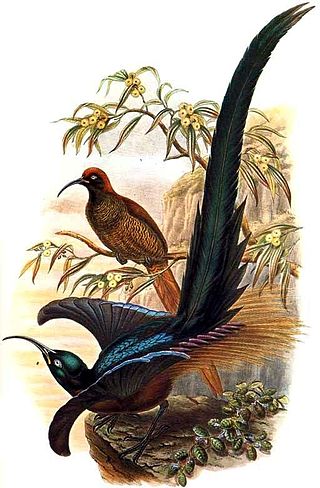
Adolf Bernhard Meyer was a German anthropologist, ornithologist, entomologist, and herpetologist. He served for nearly thirty years as director of the Königlich Zoologisches und Anthropologisch-Ethnographisches Museum in Dresden. He worked on comparative anatomy and appreciated the ideas of evolution, and influenced many German scientists by translating into German the 1858 papers by Darwin and Wallace which first proposed evolution by natural selection. Influenced by the writings of Wallace with whom he interacted, he travelled to Southeast Asia, and collected specimens and recorded his observations from the region.

The friarbirds, also called leatherheads, are a groups of 18 relatively large honeyeaters in the genus Philemon. Additionally, the single member of the genus Melitograis is called the white-streaked friarbird. Friarbirds are found in Australia, Papua New Guinea, eastern Indonesia, and New Caledonia. They eat nectar, insects and other invertebrates, flowers, fruit, and seeds.
Carl Hunstein was a German ornithologist and plant collector.

The brown sicklebill is a species of bird-of-paradise that is found in the mountain forests of New Guinea.

Meyer's parrot, also known as the brown parrot, is a species of parrot native to Africa. A Meyer's parrot has grey feathers, turquoise belly, blue rump, and bright yellow markings on the carpal joint of the wings. Most subspecies have some yellow on the top of the head as well. Forshaw (1989) recognizes six subspecies of P. meyeri which vary in home range, size and in markings, including the extent of yellow markings to the head and wings, and the intensity of turquoise markings on the belly and rump.

Meyer's goshawk is a species of bird of prey in the family Accipitridae. It is found in the Moluccas, New Guinea, the Bismarck Archipelago and the Solomon Islands. Its natural habitats are subtropical or tropical moist lowland forest and subtropical or tropical moist montane forest.

Matsudaira's storm petrel is a species of seabird in the family Hydrobatidae.

Burchell's starling or Burchell's glossy-starling is a species of starling in the family Sturnidae. The monogamous and presumably sedentary species is native to dry and mesic woodlands and savannah of southern Africa. The name of this bird commemorates the English naturalist William John Burchell.

Swinhoe's rail is a species of bird in the family Rallidae occurring in northeastern Asia. It was known only in two locations in Manchuria and southeastern Siberia, separated by more than 1000 km; however, in 2018, a new breeding population was found in the Amur region, situated between the two. Its natural habitats are swamps, freshwater lakes, freshwater marshes, and arable land. It is the world's smallest rail at 13 cm (5.2 in) and 24.5 grams. It is threatened by habitat loss, and considered a vulnerable species on the IUCN Red List.
The Vogelkop whistler is a species of bird in the family Pachycephalidae. It is endemic to West Papua, Indonesia. Its natural habitat is subtropical or tropical moist montane forests.
Brass's friarbird is a species of bird in the family Meliphagidae. It is endemic to West Papua, Indonesia.

The Timor friarbird or plain friarbird is a species of bird in the family Meliphagidae. It is found on Timor island. Its natural habitat is subtropical or tropical dry forests.

The Buru friarbird or black-faced friarbird is a species of bird in the family Meliphagidae. It is endemic to the island of Buru in the Maluku Islands, Indonesia.

The Seram friarbird, also known as the grey-necked friarbird, Ceram friarbird, grey-necked honeyeater and gray-necked honeyeater, is a species of bird in the family Meliphagidae. It is endemic to Indonesia where it occurs on Seram Island in the Maluku Islands. Its natural habitats are subtropical or tropical moist lowland forests and subtropical or tropical mangrove forests. They are common and conspicuous and often in small groups of up to four individuals.

The northern variable pitohui is a species of pitohui in the family Oriolidae. It is found on New Guinea and a number of neighbouring islands. Its natural habitat is subtropical or tropical moist lowland forests. It is also one of the few known poisonous birds.

Holub's golden weaver, also known as the African golden weaver, is a species of bird in the family Ploceidae. It is found from Gabon to Uganda and Kenya, south to northern Namibia, northern Botswana and eastern South Africa.

Temminck's seedeater is a species of bird in the family Thraupidae.

The green-capped tanager is a species of bird in the family Thraupidae. It is endemic to forest edge and gardens at altitudes of 1450–2200 m. in Puno, Peru, and La Paz, Bolivia. It is fairly common and possibly spreading, but its small population has led to it being evaluated as Near Threatened by BirdLife International and IUCN. It closely resembles the widespread burnished-buff tanager, but its mantle is bluer (male) or greener (female), and its crown is greenish-buff. Its specific name commemorates the ornithologist Rodolphe Meyer de Schauensee.

Ward's trogon is a species of bird in the family Trogonidae. Its range includes the northeastern parts of the Indian subcontinent stretching eastwards to Southeast Asia. It is found in Bhutan, India, Tibet, and Myanmar. It also has a disjunct population in northern Vietnam, but there are no recent records from there. Its natural habitats are temperate forests and subtropical or tropical moist lowland forests. It is threatened by habitat loss.

The yellow-cheeked lorikeet is a species of parrot in the family Psittaculidae. It is endemic to Sulawesi in Indonesia. It is generally common.


















